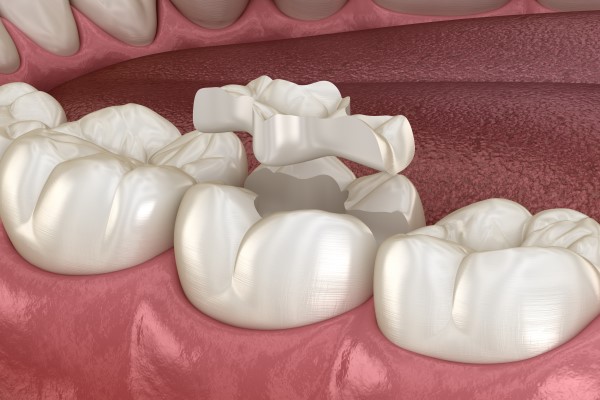Considering a dental onlay? This restoration is one that offers patients the chance to renew and rebuild teeth that are in bad shape due to damage or decay. While there are a number of existing dental restorations, onlays often get overlooked because they are rarely recommended. However, they are still a great option to look into. Keep reading to find out more about dental onlays.
What is a dental onlay and how does it work?
Below is a quick overview of dental onlays, including what they are, how they work, and what purpose they serve. This information should be reviewed by patients looking into their different dental restoration options.
Defining a dental onlay
A dental onlay is an indirect restoration that is placed over the cusps of molar teeth. Unlike inlays, onlays are used to address more extensive areas of molar teeth, meaning one or more of the cusps can be covered. Like inlays, crowns, and veneers, dental onlays are made in a lab. Once created, they are placed over the tooth using dental bonding.
Dental onlays are made of gold, silver, porcelain, or acrylic materials, all of which are strong and reliable. However, with gold and silver onlays, there is the risk of attention being drawn to the mouth. Porcelain and acrylic are white in color, which makes them hard to notice, thus allowing for a more natural-looking dental restoration.
The dental onlay procedure
A dental onlay procedure involves two appointments, with the first requiring the patient to undergo an impression. An impression is necessary in order for the dental lab to properly create the dental onlay. After a few days of waiting, the patient will return to the dentist's office for the placement of the onlay. The dentist will use a bonding solution to attach the onlay to the cusps on the molar tooth. Once set in place, the dentist will check for any hangover or excess parts that may cause irritation.
How dental onlays work and why they are recommended
Dental onlays are recommended for individuals who have damaged cusps, which can happen as a result of tooth decay, injury, bruxism, or stains. The molars are prone to staining as they interact with food the most, however, they cannot be whitened using products. With dental onlays, the cusps can be covered, thus hiding any stains permanently.
In the case of wear and tear from grinding or eating, the cusps become severely worn down, which can lead to cracking or chipping, both of which can be detrimental. Dental onlays can cover weak spots on the cusps so that the entire tooth can be restored and restrengthened.
Consult with a general dentist
Want to find out more about dental onlays? Talking with a general dentist is the best place to start. The dentist can provide specific information that can be helpful to patients who are unsure about which way to go. Additionally, questions and concerns can be addressed, and an evaluation can be done. Reach out today to get scheduled or to learn more.
Request an appointment here: https://www.drsarahlangston.com or call The Dental Wellness Group at (601) 533-4788 for an appointment in our Brandon office.
Check out what others are saying about our dental services on Yelp: Dental Onlay in Brandon, MS.
Related Posts
Will a Dental Onlay Fall Off?
The purpose of dental onlay is to restore the appearance and function of the tooth following severe tooth decay or damage. The patient will be able to use their teeth like before. …
Is a Dental Inlay the Same as a Filling?
Do you need a dental inlay to repair one of your damaged teeth? Dental inlays are indirect dental restorations, meaning the dentist creates the restoration needed and then places it into the …
Indirect Restorations: What Is a Dental Inlay and When Is It Recommended?
Learning what a dental inlay can do to improve one's overall good oral health is a great idea, as many different dental treatments are available nowadays. It depends on a dental patient's …
All About Getting a Dental Onlay
Considering getting a dental onlay? This dental restoration is used to improve the health of teeth that are in bad shape due to an injury, cavity or simple wear and tear. It …

